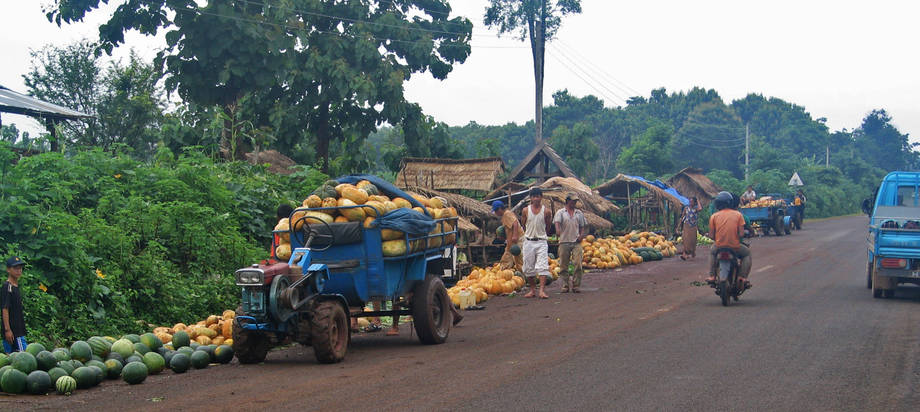ອຸຕຸກະເສດວິທະຍາ
ອົງປະກອບ1 / ໄລຍະສັ້ນ
ລະດັບມາດຕາສວນຂະໜາດນ້ອຍ, ໂຄງການນີ້ຈະສ້າງພື້ນຖານໂຄງລາງ ແລະການຕິດຕາມກວດກາລະບົບນິເວດ ແລະຂໍ້ມູນຂ່າວສານທີ່ເໝາະສົົມສຳລັບຊາວກະສິກອນ ແລະ ການຕັດສີນໃຈຂອງຜູ້ຮ່ວມທືນຂະໜາດໜ້ອຍ. ດັ້ງນັ້ນ,ຊາວກະສິກອນຈະສາມາດເອົາຄຳຕັດສີນກ່ຽວກັບເທັກໂນໂລຊີທີ່ເໝາະສົມທີ່ສຸດ ແລະ ປະເຊີນໜ້າການປ່ຽນແປງສະພາບອາກາດ. ກິດຈະກຳຂອງໂຄງການຈະເປັນການຕິດຕາມອຸຕຸກະເສດ, ການວິເຄາະ, ການສື່ສານ ແລະ ການນຳໃຊ້ຂໍ້ມູນ ແລະ ຂໍ້ມູນຂ່າວສານການຕັດສີນໃຈໃນດ້ານການກະສິກຳ ແລະ ການຄ້ຳປະກັນສະບຽງອາຫານ.
ການເພີ່ມຂື້ນການຄຸ້ມຄອງຂອງຄວາມສາມາດໃນການເກັບຂໍ້ມູນໃນຂົງເຂດຕົ້ນຕໍການກະເສດຈະຜະລິດຂໍ້ມູນຂ່າວສານທີ່ໜ້າເຊື້ອຖືໄດ້ທີ່ມີອິດທິຜົນຕໍ່ການຕັດສີນໃຈລະດັບຊາດ, ເມືອງ, ແຂວງ ແລະ ທອງຖີ່ນ. ມັນຈະລວມການປັບປຸງເຊື່ອມຕໍ່ລະຫວາ່ງລຳດັບທີ່ແຕກຕ່າງກັນ, ພ້ອມກັບກົນໄກ ແລະ ມາດຕະຖານສຳລັບການແບ່ງປັນຂໍ້ມູນ.
ໂຄງການນີ່ແມ່ນກຳລັງດຳເນີນສ້າງການຕິດຕາມທາງດ້ານອຸຕຸກະເສດ, ການສື່ສານ ແລະ ສົ່ງອຳນວຍຄວາມສະດວກຂອງການວິເຕາະລະດັບຊາດ ແລະ ແຂວງ ແລະ ຄວາມສາມາດຕໍ່ການແຜ່ຂໍ້ມູນທາງດ້ານສະຖາບັນ ແລະ ທາງດ້ານເຕັກນິກ, ການບັນລຸເປົ້າໝາຍ, ການວິເຄາະ ແລະ ການອະທິບາຍຂອງການຜະລິດຕະພັນຂໍ້ມູນທາງດ້ານອຸຕຸກະເສດຕໍ່ຜູ້ຊົມໃຊ້ທຸກລະດັບ.
ອົງປະກອບແມ່ນຖືກປະຕິບັດໂດຍກົມອຸຕຸນນິຍົມ ແລະ ອຸທົກກະສາດ (DMH) ຂອງກະຊວງຊັບພະຍາກອນທຳມະຊາດ ແລະ ສີ່ງແວດລ້ອມ (MONRE).
ຜົນໄດ້ຮັບ:
- ປັບປຸງເຄືອຂາຍສະຖານີທາງດ້ານອຸຕຸກະເສດສະຖານນີພູມອາກາດແບບຄວບຄຸ້ມ ແລະ ແບບອັດຕະໂນມັດ.
- ປັບປຸງຖານຂໍ້ມູນ ແລະ ສີ່ງອຳນວຍຄວາມສະດວກການສື່ສານໃນຂົງເຂດຜະລິດຕະພັນ ການຜະລິດກະສິກຳທີ່ສຳຄັນເພື່ອເພີ່ມທະວີການເຊື່ອມຕໍ່ລະດັບກົມອຸຕຸນິຍົມ ແລະ ອຸທົກກະສາດແຫ່ງຊາດ (DMH) ກັບໜ່ວຍງານຂັ້ນແຂວງ
- ປັບປຸງຍັກລະດັບຫ້ອງທົດລອງສຳລັບການປັບທຽບເຄື່ອງມື ແລະ ການວິເຄາະສະພາບອາກາດຢູ່ທີ່ກົມອຸຕຸນິຍົມ ແລະອຸທົກກະສາດ (DMH) ຢູ່ທີ່ວຽງຈັນ.
- ພັດທະນາຂັ້ນຕອນການດຳເນີນງານທີ່ມາດຕາ (SOPs) ແລະ ຄໍາແນະນໍາ, ແລະ ພະນັກງານທີ່ໄດ້ຝືກອົບຮົມ ຂອງພະແນກພູມອາກາດ ແລະ ກົມອຸຕຸກະເສດຂອງກົມອຸຕຸນິຍົມ ແລະ ອຸທົກກະສາດ.
- ພິຈາລະນາການຝືກອົບຮົມ ແລະ ການຈັດຕັ້ງໂຄງການຝືກອົບຮົມ (ຢ່າງໜ້ອຍ 4 ຄັ້ງ) ເພື່ອພັດທະນາການຄາດຂະເໜມູນຄາ ແລະ ຜະລິດຕະພັນຂໍ້ມູນ.
- ການພັດທະນາຫຼັກສູດຝືກອົບຮົມທີ່ກ່ຽວກັບພູມອາກາດ (ລວມທັງການຄາດຂະເໝຕາມລະດູການ), ທາງດ້ານອຸຕຸກະເສດ, ພາບຖ່າຍທາງໄກ, ລະບົບຂໍ້ມູນ ແລະ ພູມສັນຖານ, ການພະຍາກອນຜົນຜະລິດພຶດ ແລະ ການກະກຽມປັບປຸງບົດສະຫຼຸບກ່ຽວກັບພຶດ.
- ການພັດທະນາຄວາມສາມາດທາງດ້ານເຕັກນິກໃນການສື່ສານຂໍ້ມູນກ່ຽວກັບສະພາບອາກາດ, ການນຳໃຊ້ການກະກຽມຍຸດທະສາດ ແລະ ແຜນການ ແລະ ປະຕິບັດຕາມແນວທາງການຜະລິດກະສິກຳແບບຢືນຍົງໃນລະດັບແຂວງ ແລະ ລະດັບເມືອງ.
The project is also setting up the agro-meteorological monitoring, communication and analysis facilities at national and provincial level and the institutional and technical capacity on data sharing, archiving, analysis and interpretation of agro-meteorological information products to users at all levels.
The project will produce the system called Laos Climate Services in Agriculture or LaCSA. LaCSA archives and processes agro-meteorological and climatological data. By means of such data, it interpolates and provides agro-meteorological services to end-users. The system generates and delivers agro-met services to farmers by analyzing the meteorological and agriculture data. It produces seasonal forecast, and seven days bulletins. The seven days bulletin contains weekly weather bulletin, climate smart agriculture recommendations and pest and diseases risk advisory.
The component is implemented by Department of Meteorology and Hydrology (DMH) of the Ministry of Natural Resources and Environment (MONRE).
A leaflet describing the activities is available here.
Main Outputs:
- Improved/re-habilitated agro-meteorological station networks with both conventional and automatic weather stations.
- Improved data coding and communication facilities in major agricultural products areas to enhance connectivity of national Department of Meteorology and Hydrology (DMH) with provincial level sub-units.
- Upgraded laboratory for instrument calibration and agro-meteorological analysis at DMH, Vientiane.
- Developed Standard Operating Procedures (SOPs) and guidelines, and trained staff of climatology and agro-meteorology division of DMH.
- Assessed training needs and organized series of training programmes (at least 4) for development of value added forecast and information products.
- Developed training curricula related to climatology (including seasonal forecast), agro-meteorology, remote sensing and GIS, crop yield forecasting and preparation of improved crop bulletins.
- Developed technical capacity in communication of climate information, its use in preparation of strategies and plans, and in adoption of sustainable farming practices at provincial and district levels.


